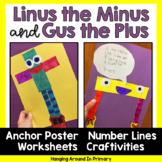Math Craft for Subtraction | Linus the Minus
- PDF
What educators are saying
Also included in
- Are you teaching Addition and Subtraction? Your students will love making these math craftivities - Gus the Plus and Linus the MInus. Also included in this pack are personal number lines, anchor charts and printables and worksheets. Included in this resource are the following:⭐Gus the Plus AdditionPrice $4.50Original Price $5.00Save $0.50
Description
Introduce your students to subtraction with this math craft for subtraction - Linus the Minus. This pack includes the Linus the Minus Craft, a ready-to-use anchor chart, a subtraction card to add to your math word wall, personal number lines for students and two worksheets to practice subtraction with a number line.
Save money and purchase this as part of a money-saving BUNDLE
Addition & Subtraction Craftivity - Gus the Plus and Linus the Minus
Included in this resource are the following:
⭐A Linus the Minus Subtraction Craftivity.
⭐An Anchor Chart for Subtraction.
⭐A card explaining subtraction for your math word wall.
⭐Number lines for students to use for independent practice.
⭐2 worksheets for subtraction.
How to use this package:
⭐Add the Math Craftivities to your Anchor Chart with addition/subtraction words, and it is an instant visual reminder for students.
⭐Have your student create their craftivity and have them fill out the speech bubble with their understanding of the operation.
⭐Use the included number lines with the worksheets for independent practice.
Check out some of my other Gus the Plus products:
Addition Centers with Gus the Plus
Addition to 20 Clip Cards with Gus the Plus
Read and Write the Room - Addition to 10 with Gus the Plus
Gus the Plus and Linus the Minus Fact Families to 20
Gus the Plus Addition to 10 BUNDLE
--------------------------------------------------------------------------------------------------------
Don't Miss Out:
Leave feedback on this item to earn credit toward future TpT purchases! Be the first to know about my new products and freebies! Look for the green star near my store name and click it to become a follower. You will receive customized e-mail updates about my store!
Connect with me via social media and my blog to see how I use my products in my classroom!






